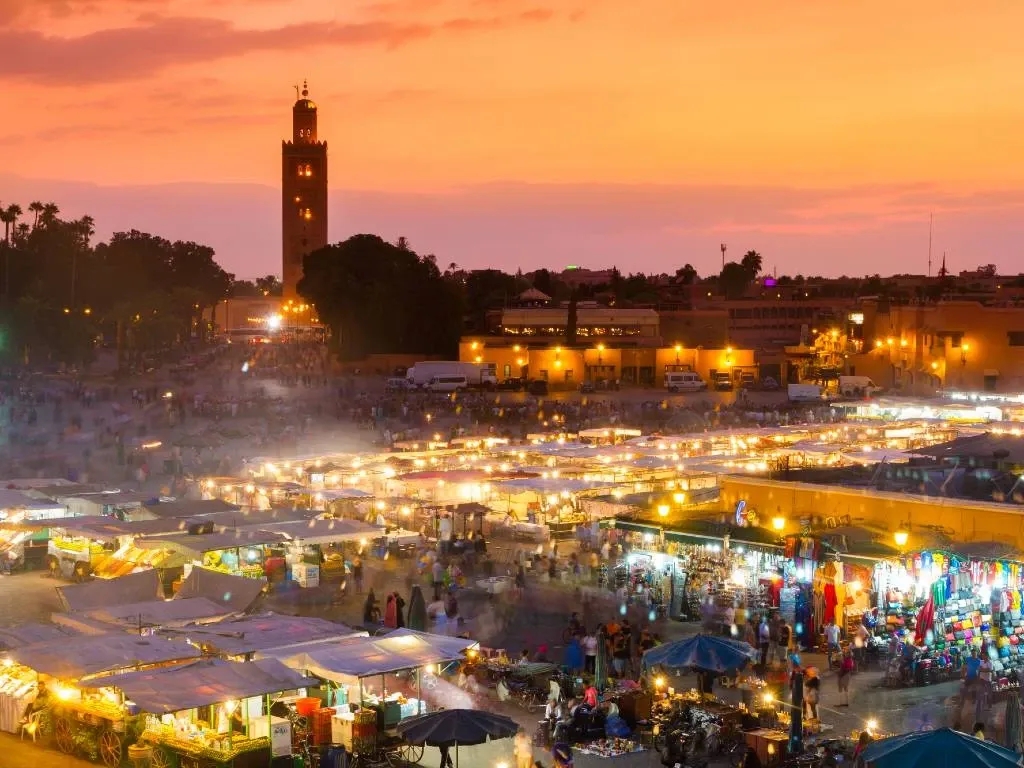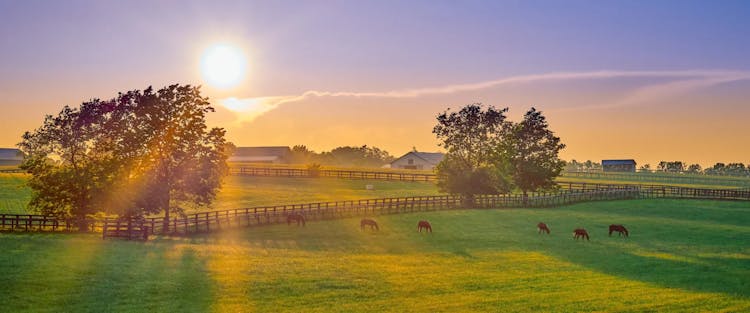
Marrakesh: The North African City Where Storytelling Is an Art
The Red City

Marrakesh is known as the Red City of Morocco for the rose pink color of its buildings. For nearly a thousand years, it provided a safe haven for the camel caravans trekking across the Sahara Desert; today it trades in foreign visitors as the country's preeminent tourist destination.
Its ancient walled city holds an almost unfathomable labyrinth of streets, squares, and blind alleys. Getting lost is part of the fun, and there's treasure hidden around almost every corner—markets to haggle in, traditional courtyard houses turned into jewel-like guesthouses, and luxury spas for unwinding after a long day of sightseeing.
The French connection
In the early 20th century, the European powers cast jealous eyes over Morocco. Under the 1912 Treaty of Fez, Morocco was supposed to keep its legal status as a sovereign state with the sultan as its figurehead. But in practice, the French grabbed control of the country and its resources until independence in 1956.
One approach to colonialism was to build a ville nouvelle (new city) alongside the existing Moroccan medinas. As a result, Marrakesh has a host of art deco buildings, concentrated in the district of Gueliz.
The villa at the Majorelle Gardens is one example. It’s set amid a splendidly planted garden laid out in the 1920s by the French artist Jacques Majorelle and then expanded by Yves Saint Laurent, who later owned it before giving it to the city. The fashion designer's own long ties with Marrakesh are celebrated at the Musée Yves Saint Laurent, housed in a strikingly modern building.
The heart of the city

You can hear the Djemaa el Fna (which can also be written Jemaa el-Fna, Djema el-Fna, or Djemaa el-Fnaa), Marrakesh’s enormous public square, long before you hear it.
Its name in Arabic means assembly of the dead and it’s been a gathering spot since the 11th century (when it was also the site of public executions). Today its cacophony of musicians, street food vendors, and people could make enough noise to rouse the departed from their graves.
Snake charmers vie for space next to traditional herbalists and acrobats tumble between tourists. Costumed water sellers tout for photos while local kids gorge themselves on candyfloss. At night, smoke and steam rise from a regiment of food stalls, selling everything from succulent kebabs to snail soup. From just about anywhere in Marrakesh, all roads eventually lead back to the Djemaa el Fna, the city's irresistible beating heart.
The art of the bargain
Ever since the Djemaa el Fna was laid out in the 11th century, souqs (street markets) have led out from the square like the threads of an intricate Moroccan carpet, albeit one whose design is never fully revealed to the visitor. You're never short of guides eager to lead you through for a fee, though half the fun is to wander aimlessly, never sure what you'll encounter next.
Something that's surely inescapable is the near-endless opportunities for shopping: finely tooled leather, neat embroidery, and brightly hammered copper, all produced in tiny workshops tucked down impossible alleys. The closer you are to the square, the higher the concentration of tourist offerings—as you head deeper into the medina you’ll find where the locals are shopping.
Carpets are unfurled, spices sniffed, and the genial game of haggling commences. In Moroccan markets, prices are only ever what the seller and buyer both agree to. Keep an eye on your luggage allowance, though, because there's always one more treasure you'll want to bring home.
A world behind closed doors

Riads are traditional Moroccan houses which face inward from the sun onto a cooling courtyard and they can feel as much of a magic trick as a place to sleep. Islamic traditions meant that decoration was reserved for the private interiors of buildings rather than the outside, so riads hide behind unassuming walls, making the act of stepping across the threshold a trip into a beautiful self-contained world.
Many riads stick to a design brief that matches their often centuries-old history, with beautifully restored mosaics, elaborate stucco, and painted wood matched with antique carpets. Others strike out into contemporary living, with cool lines and finishes straight from a design magazine. Either way, staying in a riad is one of the best ways to make your trip to Marrakesh truly unique.
The original slow cooker
Pillowy mounds of couscous and succulent tagines served in their iconic conical-lidded dishes have seen Moroccan cuisine celebrated in restaurants and home kitchens across the globe. While these dishes can be found throughout Morocco, there’s one in particular that Marrakesh likes to keep to itself.
The local specialty of tanjia is a slow-cooked wonder. Once a rough worker's dish, it’s made in a special clay amphora pot, also called a tanjia. The pot is filled with meat, preserved lemons, garlic, and spices such as saffron and cumin, and then baked for hours in the wood ovens that heat the water for the city's hammams. The end result is a succulent stew that’s well worth the wait. While it’s not quite the same, you can try to recreate the dish at home in a pressure cooker.
Sipping on Berber whisky

Few drinks are so beloved in Morocco—or come with as much ritual—as mint tea, sometimes jokingly referred to as Berber whisky. An ostensibly simple blend of green tea, fresh mint, and a tooth-melting amount of sugar, it's served scaldingly hot in tiny glasses, but only after a complicated cycle of pouring, tasting, returning to an ornate silver teapot, and topping up with more boiling water to ensure the perfect blend.
Only when the perfect balance is achieved can the tea be served—by being theatrically poured from a height of no less than twelve inches, to leave a signature rim of bubbles around the glass.
It’s meant to be sipped slowly and the refills keep coming until you wave your hand over the glass or the sugar kicks in to rouse you for the next adventure—whichever comes first.
Preserving ancient traditions
One institution that was always at the heart of the Djemaa el Fna was the city's legion of hikayat, or traditional storytellers. If you ever wondered where Scheherazade found enough tales to tell in One Thousand and One Nights Nights, Marrakesh's storytellers might give you a clue. For more than a thousand years, these storytellers have passed on traditions and cultural stories, acting as a blend of entertainer, instructor, and town crier.
This ancient art of storytelling has been threatened with extinction as older storytellers retire, but in recent years there’s been a revival. A program run by Marrakesh's Cafe Clock has gathered together the few remaining Master Storytellers to preserve their stories and perform them for visitors, as well as encourage younger Moroccans to become their apprentices and carry the tradition forward to future generations.
Steaming, scrubbing, and socializing

There is surely no better way to unwind after a long day's urban exploration than to be scrubbed, steamed, and pampered at a hammam, or traditional Moroccan spa.
A hammam is an integral part of any Moroccan medina quarter and was once the only source of hot water in the neighborhood, as well as an important place for catching up on the local gossip. An attendant massages and scrubs you to within an inch of your life, until you come out glowing pink and healthy as a newborn.
Some bathhouses, like the Mouassine Hammam, have been in business for centuries and offer the most unfiltered local experience, while others can be found in newly refurbished riads, pampering their guests with a luxurious menu of high-end spa treatments.
The Moroccan sound
The Djemaa el Fna is also known for its musicians, and those that visitors are first to encounter are usually the troupes of Gnaoua players.
The Gnaoua are the descendants of formerly enslaved West Africans. Decked out in bright djellabas (loose-fitting long-sleeved cloaks) and cowrie-shell-embroidered caps with twirling tassels, Gnaoua musicians beat out their rhythms with castanets accompanied by a three-stringed lute in complex musical phrases with roots in local Sufi prayers. For more than 20 years, the Gnaoua World Music Festival has been held about three hours from Marrakesh in the seaside city of Essaouira.
But Moroccan music isn't just of the past. Modern rhythms are just as likely to spring from hip-hop beats. Hibhub, as the genre is known in Morocco, is fast and brash, and frequently used for sharp political comment, with rappers like Houda Abouz and Gnawi courting controversy for their outspoken lyrics.
Imperial remains

While Marrakesh grew rich on the Saharan caravan trade, it owes its splendor to royal patronage. The city is one of Morocco's four imperial cities where the sultan maintained a palace (and its Royal Palace is still an official residence for King Mohammed VI).
There are plenty of other impressive historical sites remaining, too. The Bahia Palace, built for one of the sultan's viziers, is a showcase of the Moroccan decorative arts. The gorgeous Ben Youssef Medersa (once the largest Islamic college in Morocco) still dazzles visitors with its intricate mosaics and carved wooden tracery. And towering over everything is the 253-foot-high Koutoubia Minaret, a textbook example of Moorish architecture, still dominating Marrakesh's skyline as it has done for more than 800 years.
Modern Marrakesh
While the medina is the understandable focus for most visitors, Marrakesh is also a 21st-century city that looks to the future with proud confidence. The Marrakech Film Festival has been attracting big Hollywood names for years, helping to bolster Morocco's burgeoning film industry.
In 2018, the opening of the Museum of African Contemporary Art Al Maaden put the city firmly on the international art map. Artists like Hassan Hajjaj have been flying the flag for Moroccan art. His Kesh Angels photo series—of young Marrakshi women on motorbikes, wearing traditional Moroccan clothes branded with Western fashion logos—help navigate a path between the city's deep past and vibrant future.
Join Going to get cheap flights to Marrakesh delivered right to your inbox.
More destinations in Africa:
Published October 26, 2023
Last updated December 19, 2023
Articles you might like
View AllTreat your travel to cheap flights
Most deals are 40-90% off normal prices with great itineraries from the best airlines. If it's not an amazing deal, we won't send it. Sign up for free to start getting flight alerts.




